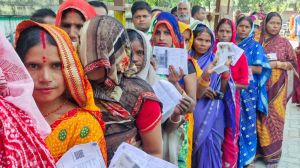First in state, plasma therapy used to treat critical Covid patient at Lilavati
Plasma therapy is still being conducted on an experimental basis across the world. Also called convalescent plasma therapy, the process aims at using antibodies from the blood of a recovered COVID-19 patient to treat those critically affected by the virus.
 This technique has been practised by several intensivists for patients suffering from breathing problems due to COVID-19. (Representational Photo)
This technique has been practised by several intensivists for patients suffering from breathing problems due to COVID-19. (Representational Photo)
In the first instance of plasma therapy in Maharashtra, plasma from a patient who had recovered from COVID-19 was used on another patient in a critical condition and on ventilator support at Lilavati hospital.
The 52-year-old patient was transfused with 200 ml of plasma on Saturday. On Sunday, he was given another transfusion of 400 ml.
Plasma therapy is still being conducted on an experimental basis across the world. Also called convalescent plasma therapy, the process aims at using antibodies from the blood of a recovered COVID-19 patient to treat those critically affected by the virus. The antibodies are transfused in a critical patient.
“We are still finalising the protocol for treatment, to decide how much quantity to give a patient depending on their condition. The entire protocol will be finalised and approved in two-three days,” said Dr Om Srivastava, who is leading the plasma therapy treatment project under BMC.
Plasma therapy has been earlier used in past to treat H1N1, Ebola, MERS, SARS and Spanish flu globally.
Don’t miss these articles on Coronavirus from the Explained section:
‣ How coronavirus attacks, step by step
‣ Mask or no mask? Why the guidance has been shifting
‣ Besides a face cover, should I wear gloves when I go outdoors?
‣ How the Agra, Bhilwara and Pathanamthitta Covid-19 containment models differ
‣ Can coronavirus damage your brain?
In this case, the 52-year-old man was admitted to Lilavati hospital, Bandra, on April 20 with fever, cough and lung infection. He was put on ventilator and remains on oxygen support since last six days.
“He is in ICU and very critical. We can certainly think of giving more plasma if there is availability,” said Dr V Ravishankar, chief operating officer, Lilavati hospital.
In Mumbai so far, only three people have donated plasma and five more are being screened for the process.
Doctors in Lilavati have also used the “prone technique” on the patient — that is, made him lie on his stomach — to see if that improves airflow to lungs. “We are doing this for 12 hours a day. We have turned him around on his stomach to expand his lungs,” Ravishankar said.
The patient continues to remain on ventilator, the tubes are adjusted in such a way that he can lie face down.
This technique has been practised by several intensivists for patients suffering from breathing problems due to COVID-19.
Author J K Rowling tweeted she was able to relieve respiratory symptoms after she tried this technique on advice of doctors. This technique is also used for acute respiratory distress patients to improve oxygenation and reduce dependence on ventilator.







